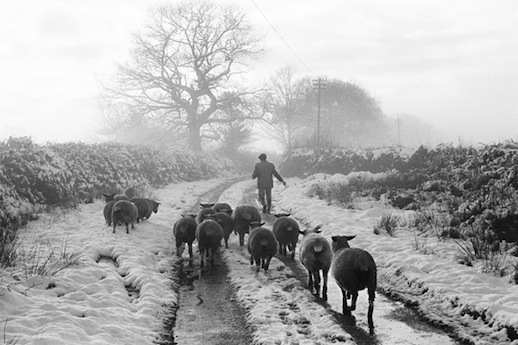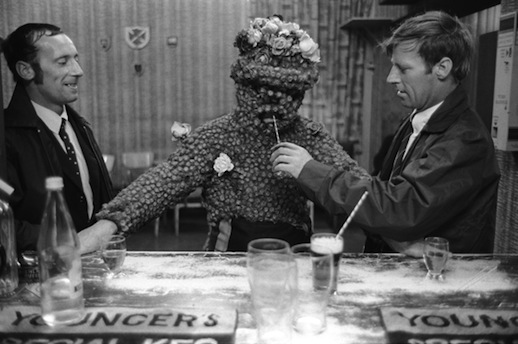The Seasons: An Elegy for the Passing of the Year by Nick Groom
A review by Jos Smith.
A walk around Tate Liverpool’s ‘Art Turning Left’, an exhibition of political art from the eighteenth century to the present, will bring you, on the upper floor, face to face with a full bodysuit of burrs, the bristly flower heads of the burdock thistle. This is the costume of The Burry Man, famously photographed by Homer Sykes in the 1970s, who appears annually in South Queensferry near Edinburgh to parade along the banks of the Firth of Forth. Up close it’s an unsettling, even an uncanny, sight. Most of us will be used to the odd burr finding its way indoors – we might have torn their little hooks from a sock or jumper – but to lean in and see a whole bodysuit made of them, including headgear, is a shock to the eye. It also raises an intriguing question about why this might be political art.
This Burry Man costume is a part of Jeremy Deller’s and Alan Kane’s Folk Archive, a collection of films, photographs, banners and costumes concerned with such subjects as competition pipe-smoking, gurning, morris dancing and hobby horses. Deller and Kane have described the archive as a ‘celebration of subjectivity’, and therein, perhaps, lies its political edge. The gurners, pipe-smokers, and the Burry Man himself confidently assert a form of popular culture that is often marginalised as eccentric or backward. And doing so today – in our age of the passive assenting consumer and the globally homogenised ‘clone town’ – demonstrates a very happy disregard for the more bland and commercially driven popular culture of television and magazines.
Nick Groom’s outstanding new book, The Seasons: An Elegy for the Passing of the Year, is similarly a politicised celebration of these forms of culture and subjectivity that have been ushered out onto the margins. It explores the way the different cultural practices of the English calendar have shaped our identity as a nation, but, interestingly, as a nation of distinctive local and regional communities rather than as one united front. Though our modern lives are not as intertwined with the agricultural year as they once were, it argues for a renewal of our seasonal culture as ‘the accumulated story of our relationship with the natural environment recorded over millennia’.
 Irwin Piper takes his sheep to slaughter
Irwin Piper takes his sheep to slaughter
There is an urgency to The Seasons that may surprise some readers, but it also really brings home what is at stake. The subtitle ‘An Elegy for the Passing of the Year’, is polemical, but could also be slightly misleading. The book is elegiac in two subtly different ways: firstly, it describes the erosion of knowledge that has traditionally connected us to the passing of the year, (vocabulary, folk songs, weather lore, saint’s days and the practice of calendar customs); secondly, it expresses an anxiety about the destabilisation of our actual climate, considering the local effects of this on agriculture or bird and insect populations (for example, a concern that the cuckoo is ‘on the cusp of becoming a metaphorical creature rather than a real bird’ in England). It is also concerned with the way these two losses are felt in combination, aggravating the sense of disorientation we feel from the annual rhythms of the land. But The Seasons is by no means sounding the funeral bell. The book is, at heart, a rallying cry simply to get involved with the English calendar in all its natural and cultural forms (and a cursory image search reveals that Groom practices what he preaches!).
This said, The Seasons is not an uncritical endorsement of calendar customs and seasonal idioms. There are some very subtle readings of conventions all too familiar today. Royalist nostalgia on the verge of the English Civil War is unearthed from seventeenth century poetry about springtime, for example. The emphasis at that time on the season’s peace, harmony and anticipation of plenty is revealed as a boat not to be rocked. Poetic convention and meteorological reality are often shown to be at odds. Likewise there is a very powerful reading of ‘the most popular book of poetry in the eighteenth century’, James Thomson’s The Seasons. Groom explores the way that the incorporation of empirical science, philosophy and nationalist politics into Thomson’s pastoral vision comes at the expense of any reference to ‘festive traditions, agricultural proverbs, weather lore, saint’s days’ or indeed the plight of the rural labouring class. Thomson’s was an aesthetic which produced a vast blind spot in the representation of the countryside, and one that seamlessly paved the way for some of the worst upheavals and dispossessions of the Enclosure Acts over the next hundred years.
For Groom, a culture out of balance with the reality of what Raymond Williams called ‘the working landscape’ is a culture, firstly, bereft of its meaningful place in the world, and secondly, without a frame of reference for contemporary change. How many of us today can say that we really understand the workings of DEFRA (which he describes as ‘a byword for incompetence’), agricultural subsidies, European legislation on food production, or perhaps most importantly the way small farmers are being driven out of business by the supermarkets (The Grocery Market Action Group recently reported that 3,000 small and medium-sized farms closed in the first ten years of this century)?
Landscape tourism and the genres of the picturesque and the pastoral have a lot to answer for in blinding us to the realities of a life lived beyond the suburbs. Towards the end, Groom even turns to Guy Debord in an attack on the representation of the rural as a spectacle to be consumed by a passive public rather than as a living culture in which to participate. And he is right to do so, since this can have very real consequences. Currently there is no obligation being put on local authorities in the UK to protect the local customs of the ritual year from such things as over-zealous safety legislation, road traffic laws and proscriptively high insurance premiums.
The Bacup Coco-nut Dance in Lancashire, for example, which A.A. Gill once described as ‘simply, awe-inspiringly, astonishingly other’, may have to stop running soon because it cannot afford the rising cost of the road closure. This is just one of numerous other traditions currently at risk. As a result, many European countries have now stepped up to protect their customs, listing them with UNESCO as a part of the Convention on Intangible Cultural Heritage but the UK is dragging its feet in what could easily become a great loss to our living heritage and cultural identity. As well as being a fascinating journey through the history of the English year, The Seasons will no doubt serve as a powerful tool in protecting and conserving many such practices that make our calendar a richly textured cultural landscape.
Jos Smith is an associate research fellow based at the University of Exeter. He has published various reviews and academic papers on the contemporary literature of the British landscape, some literary non-fiction and even some poetry. He is currently working a book about the history of the arts and environmental charity Common Ground.
